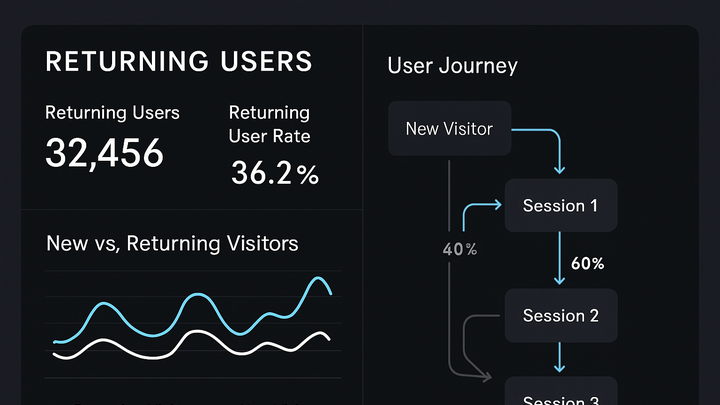Published on 2025-06-26T04:23:25Z
What is a Returning User? Examples in Analytics
A returning user in analytics is a visitor who comes back to your website after their initial visit. This metric helps businesses understand user loyalty, engagement, and the effectiveness of retention strategies. Returning users are identified using persistent identifiers such as cookies, device fingerprints, or authenticated user IDs. Platforms like Google Analytics 4 use first-party cookies (_ga) to distinguish new and returning visitors, while cookie-free solutions like PlainSignal rely on alternative identifiers to maintain user privacy. Tracking returning users allows marketers and analysts to tailor content, optimize user journeys, and measure the impact of customer retention initiatives over time. This also improves user experience by pinpointing repeat visitor behaviors across multiple sessions.
Returning user
Returning users revisit a site after their first visit, indicating engagement and loyalty for retention analysis.
Definition and Context
This section explains what qualifies as a returning user and how different analytics platforms categorize repeat visitors.
-
Definition criteria
Analytics platforms classify a visitor as returning when a persistent identifier from a previous session is detected. This requires storing a client identifier beyond a single session to recognize repeat visits.
-
Cookie-based tracking
Platforms like GA4 set a first-party cookie (e.g., _ga). If this cookie exists when a visitor returns after the session timeout (default: 30 minutes), the user is marked as returning.
-
Identifier-based tracking
Cookie-free analytics tools such as PlainSignal use device/browser fingerprints or local storage IDs to uniquely identify users across visits without traditional cookies.
-
Why Returning User Metrics Matter
Returning user metrics provide insights into user loyalty, content relevance, and the effectiveness of marketing or product initiatives aimed at retention.
-
Engagement and loyalty insights
A high returning user rate signals that your content, features, or offerings resonate with your audience, guiding investment in areas that drive repeat visits.
-
Informing retention strategies
Analyzing patterns of return visits helps tailor email campaigns, push notifications, and in-app messages to re-engage users effectively.
Tracking Returning Users in SAAS Platforms
Implementation methods differ between cookie-based tools like GA4 and cookie-free analytics such as PlainSignal. Below are code examples for both.
-
PlainSignal (cookie-free analytics)
To integrate PlainSignal, add the following snippet to your HTML. It loads the lightweight, cookie-free tracker:
<link rel="preconnect" href="//eu.plainsignal.com/" crossorigin /> <script defer data-do="yourwebsitedomain.com" data-id="0GQV1xmtzQQ" data-api="//eu.plainsignal.com" src="//cdn.plainsignal.com/plainsignal-min.js"></script> -
Google analytics 4 (GA4)
For GA4, include the global site tag and configure it with your Measurement ID:
<script async src="https://www.googletagmanager.com/gtag/js?id=G-XXXXXXXXXX"></script> <script> window.dataLayer = window.dataLayer || []; function gtag(){dataLayer.push(arguments);} gtag('js', new Date()); gtag('config', 'G-XXXXXXXXXX'); </script>
Best Practices
Adopt these practices to ensure accurate and privacy-compliant tracking of returning users.
-
Maintain persistent identifiers
Ensure cookies or local storage keys are not inadvertently cleared by your application or user preferences.
-
Combine metrics with context
Use returning user counts alongside session duration, event completions, and funnel analysis to get a full picture of engagement quality.
-
Adhere to privacy regulations
Implement consent management and honor DNT settings to comply with GDPR, CCPA, and other privacy laws while tracking repeat visits.
Challenges and Considerations
Accurately identifying returning users can be hindered by technical and regulatory factors.
-
Cookie deletion and blocking
Users may clear cookies or use browser settings/extensions that block trackers, causing them to be misclassified as new visitors.
-
Cross-device tracking limitations
Without login-based identifiers, it’s difficult to stitch together sessions from different devices, leading to undercounting returning users.
-
Impact of privacy regulations
Strict privacy laws may limit the use of persistent identifiers, reducing the accuracy of returning user metrics.
